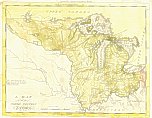|
|
 |
 |
|
Reading Guide |
| 1. |
The Northwest Ordinance, 1787
|
|

Northwest Territory, 1796
|
|
As the Americans established their new republic, they knew they were embarking upon a treacherous enterprise. Republics had a bad track record. They were unstable and vulnerable to splitting apart through the disputes of warring factions. Adding to this anxiety was the challenge of incorporating the western territories into the Union. Could a republic successfully encompass such a vast expanse and remain united? The Northwest Ordinance, the single most important piece of legislation passed under the Articles of Confederation, addressed this problem. It set forth the means to create new states west of the Appalachians and eventually admit them into the Union. In the Ordinance the United States did what no other empire ever did: it brought new territories under its dominion on an equal footing with the original metropolitan states. The Ordinance extended the Revolution into the new territories by guaranteeing that settlers in them would be equal citizens of the United States and enjoy all the rights of citizenship. Although a rather dry procedural document, it nonetheless presents the image of itself that the new nation planned literally to project into the world. 6 pages.
Discussion questions
| · |
What does the Northwest Ordinance say about republican fears as the nation moves west? |
| · |
Why do the republicans of the east coast, who believe in legislative power, invest so much power in the territorial governors of the west? |
| · |
How does the Ordinance protect settlers from excesses of executive power? |
| · |
How is executive power overcome? |
| · |
How is the Northwest Ordinance a plan to overrun Native Americans? |
| · |
How does the Ordinance tie the territories to the United States? |
| · |
Why does the Congress enter into a "compact" with the settlers of the territories? |
| · |
Why does the Ordinance prohibit slavery in the territories?
|
» Link |
 |
 |
Topic Framing Questions
| • |
What implications did westward migration hold for national unity? |
| • |
How did the citizens of the early republic think about Native Americans and their place in the developing nation? |
| • |
How did Native Americans respond to the westward press of the United States? |
| • |
How did the United States respond to the presence of Native Americans on the western frontier?
|
|
|
 |
 |
|
 |
